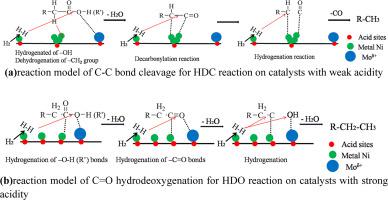Catalysis Communications ( IF 3.4 ) Pub Date : 2020-11-11 , DOI: 10.1016/j.catcom.2020.106235 Shilei Ding , Fuwei Li , Zhixia Li , Hongchang Yu , Caifeng Song , Deyuan Xiong , Hongfei Lin

|
Waste cooking oil (WCO) and stearic acid (SA) were considered to be renewable and readily available bio-oil resources to produce bio-fuel via catalytic hydrodeoxygenation. The most often used catalysts for hydrodeoxygenation were the vulcanized NiMo catalysts, however, the vulcanized catalysts tend to deactivate due to the loss and oxidation of sulfur upon treating bio-oil with high oxygen content. Therefore, it is necessary to develop sulfur-free catalysts. In present study, the reduced NiMo catalysts were prepared by loading Ni and Mo on different supports (γ-Al2O3, HZSM-5, β-zeolite, activated carbon and bentonite) using incipient-wetness impregnation method, and followed by H2 reduction. The effects of the properties of supports (acidity, porosity) and H2 reduction on the dispersity and valence state of metal components were investigated. The hydrodeoxygenation activities of the reduced catalysts were evaluated by catalytic WCO and SA. It was found that when Ni2+ was loaded on a slightly acidic supports such as γ-Al2O3 and activated carbon, Ni2+ was easier to be reduced, and aggregate to form larger particles. When Ni2+ was loaded on a strongly acid supports e.g. HZSM-5, β-zeolite or bentonite, Ni2+ was more difficult to be reduced but could uniformly disperse on the supports. The aggregated Ni atoms could promote the formation of C17, while the dispersed Ni atoms could promote the formation of C18. γ-Al2O3 supported catalyst achieved the highest SA (97.9%) and WCO (80%) conversion under the mild reaction conditions of 300 °C and 2 MPa H2 for 3 h, exhibiting the superior catalytic activity.
中文翻译:

废镍基催化剂上的食用油和硬脂酸催化加氢脱氧
废弃的食用油(WCO)和硬脂酸(SA)被认为是可再生的,易于获得的生物油资源,可通过催化加氢脱氧来生产生物燃料。加氢脱氧最常用的催化剂是硫化的NiMo催化剂,但是,硫化的催化剂由于在处理含氧量高的生物油时硫的损失和氧化而趋于失活。因此,有必要开发无硫催化剂。在本研究中,通过加载Ni和Mo在不同的载体中制备的还原的NiMo催化剂(在γ-Al 2 ö 3,HZSM-5,β沸石,活性炭,膨润土),使用初湿含浸法,并随后用H 2减少。载体性质(酸度,孔隙度)和氢的影响研究了2还原对金属组分的分散性和价态的影响。还原的催化剂的加氢脱氧活性通过催化WCO和SA评估。据发现,在Ni 2+是在微酸性载体如γ-Al系装载2 ö 3和活性炭,镍2+是更容易被还原,并聚集形成较大的颗粒。当将Ni 2+负载在强酸载体例如HZSM-5,β-沸石或膨润土上时,Ni 2+更难以还原,但可以均匀地分散在载体上。聚集的Ni原子可以促进C17的形成,而分散的Ni原子可以促进C18的形成。γ-铝2O 3负载的催化剂在300°C和2 MPa H 2的温和反应条件下3 h达到最高的SA(97.9%)和WCO(80%)转化率,表现出优异的催化活性。











































 京公网安备 11010802027423号
京公网安备 11010802027423号